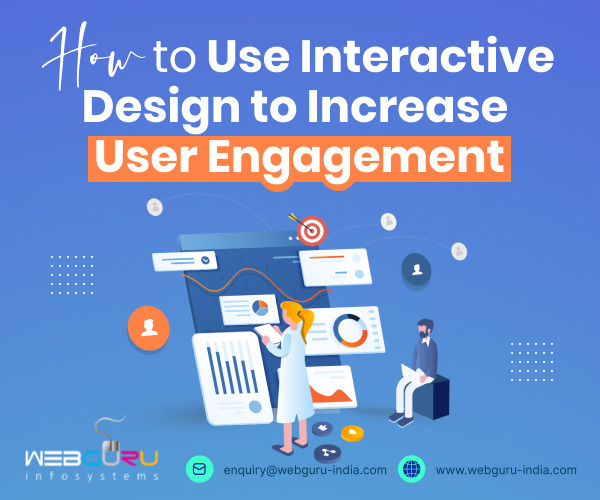Home Blog Website Design Services How to Use Interactive Design to Increase User Engagement
How to Use Interactive Design to Increase User Engagement
- 18 Sep / 2023
- 8,264 views
- 7 Min Read

Interactive design is an important part of user experience (UX) design that focuses on generating compelling and accessible digital experiences for visitors. It entails creating interfaces and interactions that let users actively engage in and interact with the content or functionality of a website, application, or other digital platform. By adding components like animations, gestures, feedback systems, and user-friendly navigation, interactive design strives to improve usability, satisfaction, and total user engagement. Availing bespoke website design services can be advantageous to companies that intend to impress and captivate customers with ease. Professional designers can bring your brand’s vision to life and maximize its conversion potential. Read on to gain further insight.
Why Interactive Design is Crucial for User Engagement
Every business relies on its website to showcase its goods, services, and distinctive personality. With growing competition in the digital realm, it is critical for businesses to build one that not only stands out physically but also delivers an enjoyable user experience. This is where interaction design comes into play.
Companies may attract their consumers’ attention and keep them interested for extended periods of time by including interactive components like animations, movies, and interactive features. Furthermore, interactive design enables tailored experiences, allowing customers to feel more connected to the brand. Web design also has a direct impact on SEO outcomes and is the difference-maker for many businesses.
Here are some strategies and tips on how to use interactive design to increase user engagement –
Understand Your Audience:
- Start by researching and understanding your target audience’s preferences, needs, and pain points. Tailor your interactive design to cater to their specific interests and expectations.
Feedback Mechanisms:
- Provide immediate and clear feedback to users when they interact with your platform. Use animations, notifications, or changes in the interface to acknowledge their actions. These are some of the elements that can leave a lasting impression on your website visitors.
Interactive Content:
- Incorporate interactive elements within your content, such as clickable infographics, interactive quizzes, videos, or polls. These elements can keep users engaged and provide valuable information.
Clear and Intuitive Navigation:
- Make sure your navigation menus and user interface components are simple to grasp and utilize. Potential consumers ought to be able to swiftly locate what they are searching for. Designers work closely with professionals offering web development services to create highly intuitive layouts.
Gamification:
- Introduce game-like features, such as badges, points, and challenges, to make the user experience more enjoyable and motivating. Gamification can encourage users to return to your platform.
Personalization:
- Utilize user data and preferences to personalize the user experience. Recommendations, customized content, and tailored interactions can make users feel more connected to your platform.
User-generated Content:
- Encourage users to contribute their content, comments, reviews, or ratings. This not only fosters engagement but also builds a sense of community around your platform. Feedback from your user base helps build trust among potential customers.
Chatbots and Virtual Assistants:
- Implement chatbots or virtual assistants to provide instant assistance and engage users in conversations. These AI-driven tools can answer questions, offer recommendations, and guide users through your platform.
Progress Tracking:
- Display progress bars or completion meters for tasks or goals within your platform. This helps users track their achievements, which can be motivating and keep them engaged. Your team can easily use the earned engagement to target more conversions.
Responsive Design:
- Ensure your interactive elements work seamlessly on various devices and screen sizes. Responsive design is critical to maintaining engagement across different platforms. A lot of users now check business websites and apps on mobile, but some also prefer to view the same information on their desktops when at home.
A/B Testing:
- Continuously test different interactive design elements and features to see which ones resonate most with your audience. Use data-driven insights to refine and optimize your design.
Loading Speed Optimization:
- Slow-loading pages can drive users away. Optimize your platform’s performance to ensure fast loading times for interactive elements. Business owners availing of website design services need to convey the requirement for fast-loading webpages.
Accessibility:
- Make sure your interactive design is accessible to all users, including those with disabilities. Provide alternative text for images, keyboard navigation options, and other accessibility features.
User Feedback and Iteration:
- Encourage users to provide feedback on the interactive features and act on their suggestions. Regularly update and improve your design based on user input. Take this vital step to turn your landing pages into ones that leave a lasting impression.
Social Sharing:
- Integrate social sharing buttons and features so users can easily share their interactions and achievements with their networks, increasing your platform’s visibility. Doing so can encourage users to spread the word about your products and services.
Analytics and Insights:
- Analytical tools can be used to monitor user involvement and activity. Recognize how consumers engage with your platform, then utilize this information to guide your design choices. This will enable you to more successfully target high-value prospective clients.
Steps to Integrate Interactive Website Design for Enhancing User Engagement
- Research and analysis: Understanding the project’s goals, target market, and market trends is the first phase of research and analysis. To determine user requirements and preferences, it also entails data collection and user research.
- Conceptualization: During this stage, designers generate concepts and ideas for the interactive design while taking user flow and functionality into account. These ideas aid in establishing the interactive project’s general structure and characteristics.
- Prototyping and wireframing: These techniques are used to illustrate the structure and functioning of a design. Prototypes are interactive mockups that enable user testing and feedback whereas wireframes are simple, static representations of the interface.
- Design and visual elements: During this step, the graphics, color schemes, typography, and pictures for the interface are all developed. A coherent, visually beautiful design that is in keeping with the project’s objectives and brand identity is the aim.
- Development and programming: To make the interactive features come to life, developers turn the design into usable code. They make sure that the interface responds well to various devices and screen sizes and operates smoothly.
- Testing phase: Usability testing is carried out to find any usability problems and get user input. The design will be improved and refined as a result of this input. Designers work closely with professionals offering web development services to carry out this kind of testing.
- User Interface (UI) design: UI designers concentrate on the interface’s finer points, maximizing user interactions, and ensuring that design components are consistent. This action is essential for improving the user’s overall experience.
- Content integration: Interactive design incorporates content, such as text, photos, videos, and data, to ensure that it complements the overall user experience and aesthetics.
- Bug fixing and quality assurance (QA): Extensive testing is done to find and fix any bugs, malfunctions, or problems with the interactive design. For the user experience to be smooth, this stage is crucial.
- Launch and deployment: After all testing and revisions are finished, the interactive design is transferred to the platform or environment it was designed for, allowing people to access it.
- Monitoring: After launch, continuous monitoring and maintenance are necessary to handle any new problems, upgrades, or modifications needed to keep the interactive design functioning and relevant over time.
Conclusion
Interactive design has proven to be crucial for providing optimized user experiences and enhancing conversion potential. Incorporating it can help your business outrank and outshine your closest competitors. Get in touch with us to gain some insight into our website design services.

Saurav Majumdar
Saurav Majumdar is a curious mind with a never-ending quest for knowledge.
5 comments
Leave a Reply

-
1000+
Happy
Clients -
25+
Countries
Served -
19+
Years of
Trust








Great article! I appreciate the insightful exploration of interactive design and its impact on enhancing user engagement. The examples provided offer valuable inspiration for creating immersive digital experiences. Keep up the excellent work.
Web design isn’t just about aesthetics; it’s about creating experiences. Gamification adds layers of interactivity, making websites memorable journeys.
Major thankies for the blog.Really looking forward to read more. Keep writing.
Interesting content. This will certainly be helpful.
The aticle seems to be very profound.